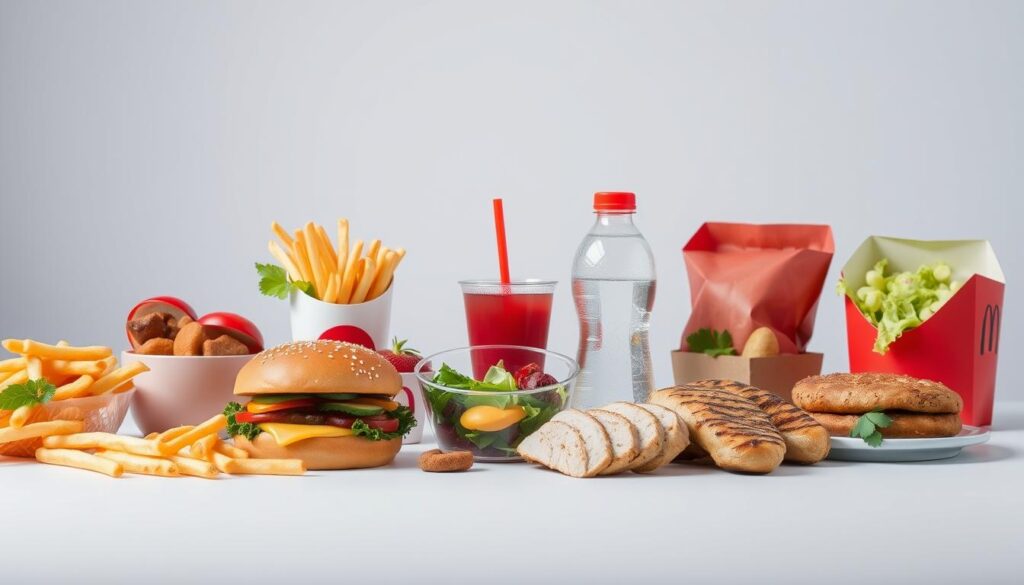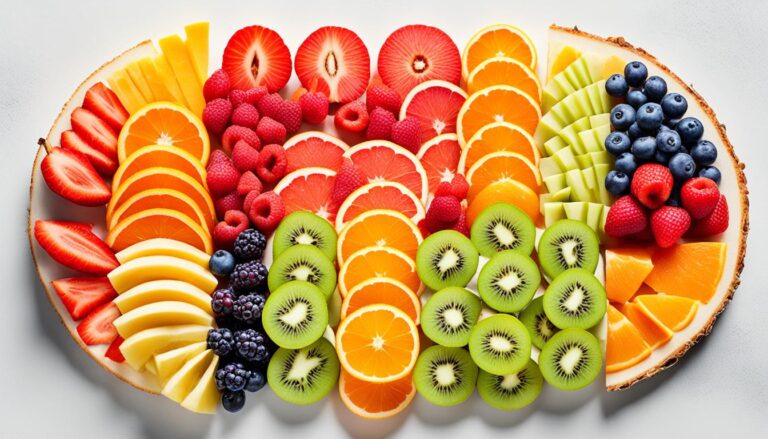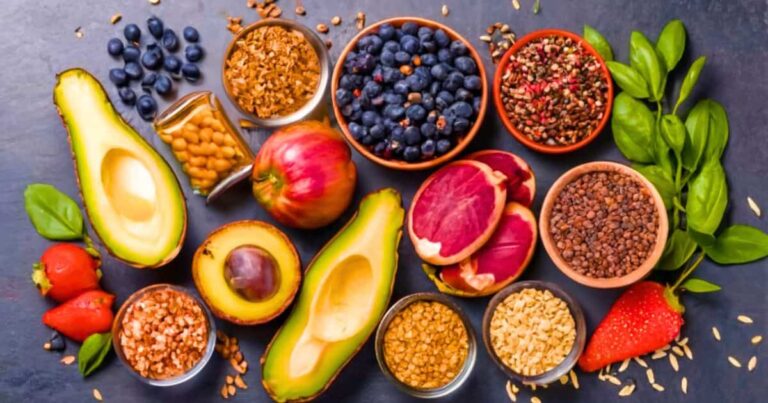Fast food tips often tell us to cut it out. But what if we could enjoy it in moderation? The “bliss point” in food design makes fast food hard to resist. Brain scans show cravings are like drug addiction, yet we can take back control.
Most adults don’t realize how much sodium is in fast food. This can lead to high blood pressure and diabetes. This guide offers ways to eat less fast food without feeling deprived. It’s based on science about our brains, nutrition, and behavior.
Key Takeaways
Key Takeaways
- Fast food’s addictive qualities stem from engineered flavor “bliss points.”
- 90% of adults underestimate sodium content by over 1,000 mg per meal.
- Mindful eating practices reduce overconsumption by 30-50% in clinical trials.
- Phthalates in processed foods may disrupt hormonal balance, impacting long-term health.
- Strategic planning cuts fast food spending by 40% while maintaining enjoyment.
Understanding the Fast Food Trap: Why It’s So Hard to Resist
Fast food has a strong hold on our diets. It’s a mix of biology, engineering, and lifestyle. This section looks at how these factors make it hard for even the most determined people to resist.
The Science Behind Fast Food Cravings
Fast food plays with our brain chemistry. It activates dopamine pathways, similar to drugs like cocaine. The high calorie density in junk food triggers reward signals, leading to a craving cycle.
Studies reveal 71% of Americans face weight issues due to these cravings.
How Fast Food Companies Engineer Addictive Foods
Big chains like McDonald’s and KFC aim for the “bliss point.” This is a mix of salt, sugar, and fat that tastes incredibly appealing. Dr. Howard Moskowitz made this concept a reality.
- Salt: Enhances flavor and hides poor-quality ingredients
- Sugar: Causes quick dopamine spikes
- Texture: Crispy coatings and creamy sauces create sensory pleasure loops
The Convenience Factor: Time, Accessibility, and Decision Fatigue
Fast food is a default choice in today’s busy world. It’s quick, affordable, and easy to find. It takes advantage of decision fatigue—the mental exhaustion from daily choices.
When we’re stressed or in a hurry, we often choose fast food. This is because it’s familiar and instantly satisfying.
Understanding these factors is the first step to avoid fast food cravings and overcome fast food addiction. By knowing the science behind cravings and corporate tactics, we can make better choices. We can start to break free from the fast food trap, one informed decision at a time.
The Real Impact of Regular Fast Food Consumption on Your Health
Regular fast food eating harms many parts of your body. It can hurt your heart and even your mind. Studies show clear signs of damage from eating these meals often.

- Blood sugar and metabolism: Foods high in refined carbs and sugar cause big ups and downs. This messes with how your body uses energy and insulin.
- Cardiovascular strain: Foods with lots of salt, like a bacon cheeseburger, can make your blood vessels work too hard. This can lead to high blood pressure and heart disease.
- Inflammation and immunity: Foods with saturated and trans fats can make your body inflamed. This weakens your immune system and makes you more likely to get sick.
- Digestive health: Foods low in fiber, like a blueberry muffin, can slow down digestion. This can cause constipation and other gut problems.
- Neurological effects: Eating a lot of saturated fats can hurt your memory and increase depression, more so in women.
“The more you eat junk food, the more you crave it. By following the simple steps, you can break the cycle today and lead a healthier life.”
Studies show eating less fast food can improve your cholesterol and insulin levels. Making small changes, like choosing grilled over fried, can help. Adding veggies to your meals is a good start. Making these changes regularly can lead to big improvements over time.
How Do I Control Eating Fast Food? Practical Strategies That Work
Effective fast food consumption tips need steps that fit your life. Start by setting clear limits to reduce fast food intake. Proven methods can help you make better choices.
Start by Setting Realistic Consumption Limits:
- Limit fast food meals to 1–2 times weekly, as dietary guidelines suggest.
- Have regular meals and snacks to avoid eating too much when hungry.
- Drink water first to see if you’re really thirsty, not hungry.
Creating Personal Rules for Fast Food Occasions means setting clear limits. For example:
- Eat fast food only at social events.
- Choose healthier options like grilled over fried.
- Stay away from drive-thrus to avoid impulse buys.
These rules help you stick to your health goals.
Using Technology to Track and Limit Consumption is helpful. Tools like:
- Meal-tracking apps (e.g., MyFitnessPal) to log what you eat and track progress.
- Budget apps to see how much you spend on fast food and save money by eating less.
- Phone reminders to pause before making an impulsive order.
Technology makes it easier to follow through on your goals.
The 24-Hour Rule helps you delay acting on cravings. When you feel like eating fast food, wait 24 hours. Often, the urge goes away, letting you make a better choice. Also, eat slowly and enjoy your food to feel fuller.
Using these strategies together helps you build lasting habits. Small changes, like choosing healthy snacks or getting enough sleep, can also help. It’s about making progress, not being perfect.
Mindful Eating Practices: Transforming Your Relationship with Food
Mindful eating helps you avoid fast food cravings by tuning into your body’s hunger signals. It focuses on being aware of what you eat, not just eating on autopilot. This method tackles both physical and emotional reasons for eating.
“There’s almost always an emotional component behind cravings… Practicing mindful eating can reduce stress and improve mood, fostering healthier choices.” — Clinical research findings
CHEAR’s ROC program teaches important strategies to spot emotional triggers:
- Pause before eating to check hunger levels (0-10 scale)
- Use breathwork to calm stress-induced cravings
- Track emotional states in a food journal

| Behavior | Savoring (Mindful) | Scarfing (Mindless) |
|---|---|---|
| Eating Speed | 15-20 chews per bite | Swallowing large mouthfuls |
| Distractions | No screens or multitasking | Mealtime scrolling/social media |
| Portion Control | Stop at 70% fullness | Eating until plate is clean |
Studies show mindful eaters eat 20% fewer calories at each meal. CHEAR’s CBT tools teach:
- Pause for 10 seconds before eating
- Identify food’s texture, aroma, and taste
- Pause between bites to assess fullness
By adopting these habits, you can make eating choices that match your nutritional needs, not just emotional cravings. Medical studies back this up, showing it improves digestion, cuts down on overeating, and helps with weight management over time.
Smart Ordering: Making Healthier Choices at Fast Food Restaurants
Learning nutrition tips for fast food can change how you eat out. First, check menu labels or websites to see calorie counts and ingredients. Choose lean proteins like grilled chicken or turkey burgers over fried foods.
Try removing buns or using lettuce wraps to cut carbs without losing flavor.
- Ask for extra veggies in sandwiches or salads to increase fiber and nutrients.
- Swap fries for apple slices, carrot sticks, or side salads with low-fat dressings.
- Order water, unsweetened iced tea, or sparkling water instead of sodas.
- Limit condiments—mayo and creamy sauces add hidden fats. Ask for ketchup or mustard instead.
Controlling portion sizes is key. Choose small or kid-sized meals to avoid eating too much. At taco stands, try a “naked taco” without the tortilla to reduce carbs.
For pizza, pick a whole-wheat crust and add extra veggies like spinach or mushrooms. These healthy eating habits help keep things balanced without giving up your favorite places.
Fast food chains like Subway offer veggie wraps, while Chipotle lets you build bowls with brown rice and beans. Always say no to sugary toppings like bacon or extra cheese unless it’s a rare treat. Making small changes like these can lead to lasting improvements without feeling too restricted.
Meal Planning and Prep: Your Secret Weapon Against Fast Food Dependency
Meal planning changes how we eat, making it more intentional. It helps us reduce fast food intake. By planning meals ahead, we avoid the quick, unhealthy choices of fast food.
Planning meals in advance helps ensure a balanced diet and reduces reliance on unhealthy options.
Meal Planning Strategies for Busy People
- Use apps like Mealime or Yummly to generate customizable weekly plans.
- Set aside one weekend hour for meal planning, matching recipes with sales.
- Try a “theme day” system (like Taco Tuesday) to make shopping easier.
Quick and Easy Meal Prep Ideas That Beat the Drive-Thru
Batch-cooking items like roasted veggies or grain salads makes meals fast. Try these ideas:
- Sheet-pan dinners with protein, veggies, and grains
- Freezer-friendly soups and chili for quick lunches
- Pre-portioned snack packs with nuts, fruit, and veggies
Budget-Friendly Alternatives to Fast Food
One family saved $2,880 a year by changing their eating habits. They did this by:
- Choosing store-brand items like rice, beans, and canned tomatoes
- Turning leftovers into new meals
- Using frozen pizza for rare treats
Studies show meal planning can cut fast food spending by 40%. It also boosts nutrition. Begin with just three planned meals a week. It’s a step towards lasting change.
Breaking the Fast Food Addiction: Psychological Techniques and Support Systems
Getting over fast food addiction means tackling the psychological side and having a supportive circle. The brain’s reward system, driven by dopamine, makes us crave foods high in sugar and fat. It’s important to notice feelings of guilt after eating or using food despite health problems.
Studies show that changing behavior and having social support can lead to success. This is because the brain’s addiction pathways are similar to those of substance abuse.
Identifying the Path to Recovery
Food addiction works in the brain like substance abuse. Use the Yale Food Addiction Scale (YFAS) to check for symptoms like withdrawal or losing control. A 2013 study found that changing how we see trigger foods can reduce cravings.
Key signs include:
- Trying to quit but can’t despite health issues
- Feeling irritable or anxious when not eating
- Keeping eating even when it hurts
Cognitive Behavioral Strategies
Cognitive Behavioral Therapy (CBT) works on changing thoughts and actions. It uses:
- Cognitive Restructuring: Challenge negative thoughts with facts.
- Stimulus Control: Remove fast food ads and fill kitchens with healthy foods.
- Urge Surfing: Practice mindfulness to watch cravings without acting on them.
Building a Support Ecosystem
Join groups like Overeaters Anonymous for support. Doctors might prescribe naltrexone to help with cravings. Mix professional help with support from others to keep up healthy eating habits.
Workplace or school programs can help by sharing goals. This way, everyone works together towards better eating.
“Motivational interviewing helps individuals align dietary changes with personal values.”
Using proven methods and social support leads to lasting change. Begin by finding out what triggers your cravings. Then, slowly add strategies to your daily life.
Creating a Balanced Approach: When and How to Include Fast Food in a Healthy Diet
Adding fast food to a healthy diet needs careful planning and nutrition tips for fast food. Try the 80/20 rule. Eat nutrient-rich foods most days and enjoy treats sometimes. Here’s how to make good choices without losing sight of your health goals:

- Choose Wisely: Pick “healthy choices” menus at places like McDonald’s or Subway. Go for grilled meats like the Filet-O-Fish or chicken sandwiches instead of fried ones.
- Portion Control: Eating smaller meals can cut calories by 30–50%. Swap fries for a side salad or fruit cup to reduce carbs by 35+ grams.
- Drink Smart: Drink water, unsweetened tea, or diet soda instead of sugary drinks. Mixing water with sugary drinks can cut sugar intake by up to 50%.
- Time and Context: Use fast food for travel or social events. Make homemade meals most days to keep your diet balanced.
- Post-Meal Adjustments: After eating too much, drink more water and move around. A 30-minute walk can help burn off extra calories from a burger.
| Typical Choice | Healthier Alternative |
|---|---|
| Regular fries (360 cal, 30g fat) | Side salad (120 cal, 4g fat) |
| Quarter Pounder with cheese (720 cal) | Grilled Chicken Sandwich (400 cal) |
| Soda (200 cal/15g sugar) | Unsweetened iced tea (0 cal/0g sugar) |
“A 500-calorie threshold per meal supports metabolic stability,” says BreAnn Erickson, RDN. “Pair fast food with plant-based sides to boost fiber intake.”
Fast food consumption tips include pre-ordering online to check nutrition facts. Talk to a registered dietitian for advice on fitting fast food into your long-term health plan.
The “Fast Food Alternative” Cookbook: Recreating Your Favorites at Home
Healthy meal planning turns cravings into chances for nutritious meals. This section shows how to make fast food favorites with whole ingredients and balanced nutrition.
“Over time, your body and palate will get used to fresh vegetables, fruit, grains, and proteins. Your cravings for processed options will fade as these healthier foods become satisfying.”
Healthier Burger and Fry Recipes
Start with oven-baked sweet potato fries dusted with cinnamon and paprika. For burgers, try:
- Black bean patties with quinoa for protein
- Zucchini “fries” baked with olive oil spray
- Ground turkey blended with oats and herbs
Pizza Alternatives That Satisfy Cravings
Whole-wheat crusts topped with roasted veggies and low-moist cheeses offer savory options. Consider:
- Portobello mushroom caps as pizza bases
- White bean puree as a pizza sauce alternative
- Grated zucchini layers for low-calorie crusts
Sweet Treats That Replace Fast Food Desserts
Swap sugary desserts with:
- Dark chocolate-dipped banana bites
- Chia seed pudding with fresh berries
- Avocado “mousse” with lime and stevia
Add these recipes to your weekly meal plans to support healthy eating habits. Homemade versions cut sodium by 40% and boost fiber by 50% compared to restaurant options. Use smoked paprika or garlic powder to add flavor without extra salt.
Conclusion: Taking Control of Your Fast Food Habits One Day at a Time
Mindful eating is key to lasting change. Studies show eating more nutrient-rich foods helps cut down on fast food. A study in Nutrients found that focusing on good habits works better than just saying no to fast food.
Starting small can lead to big changes. Within two days, blood sugar levels and mood swings improve. By the first week, you might start losing weight. And after a month, you’ll see better physical health like a smaller waist and clearer skin.
Tools like the Health Star Rating system and apps like FoodSwitch make healthy choices easier. When cravings hit, try making your favorite dishes at home. Small changes, like drinking water instead of sugary drinks, add up over time.
It’s okay to slip up sometimes. Apps like MyFitnessPal help track your habits. If you face bigger issues, like binge eating, get help from a professional. Remember, enjoying fast food in moderation is okay when you eat mindfully. Focus on whole foods and small changes for better health without sudden drastic actions.
FAQ
What are some fast food consumption tips for maintaining healthy eating habits?
To eat healthy while having fast food, set a limit on how often you eat it. Choose grilled over fried and go for smaller portions. Also, watch out for hidden calories in sauces and drinks.
How can I avoid fast food cravings during the week?
Overcoming cravings starts with knowing what triggers them. Try the “24-hour rule” to delay acting on cravings. This can help you make better choices.
What are some mindful eating practices to incorporate into my routine?
Mindful eating means eating with full attention. Recognize why you’re eating and enjoy each bite. Try breathing exercises and eating slowly to appreciate your food more.
How can I effectively reduce my fast food intake?
To eat less fast food, plan your meals and set limits. Use apps to track what you eat. Slowly replace fast food with homemade meals to break the habit.
What nutrition tips can I follow when ordering fast food?
Choose grilled options and whole grains when ordering. Avoid high-calorie sauces. Look at nutritional info to make better choices.
How can meal planning help overcome fast food addiction?
Meal planning gives you structure and helps you prepare healthy meals. This makes it easier to resist fast food. Plan and prep meals to avoid the urge for fast food.
What are some healthy meal planning strategies to prevent fast food consumption?
Plan meals in advance and use apps for help. Create flexible plans for busy days. Choose easy recipes that fit your health goals.
How can I create a balanced approach to including fast food in my diet?
Use the 80/20 rule for a balanced diet. Eat healthy 80% of the time and enjoy fast food 20% of the time. This avoids guilt and keeps you on track.
What are healthier alternatives to popular fast food items I can cook at home?
Make healthier versions of fast food at home. Try veggie burgers, whole grain pizzas, or desserts with natural sweeteners. These are nutritious and can change your taste preferences.
How can I support my dietary changes and maintain progress?
Surround yourself with people who support your diet. Keep track of your progress and reward yourself. This boosts motivation and helps you stay on track with your health goals.





